Abstract
STUDY OBJECTIVES: To identify the determinants of childhood pedestrian injuries, taking the child's exposure to the road environment into account. DESIGN: This was a case-control study. SETTING AND PARTICIPANTS: The study was conducted in Perth, Western Australia between 1991 and 1993. Altogether 100 injured and 400 uninjured child pedestrians aged 1 to 14 years were studied. Aspects of the child's social and physical environments, measures of his or her behaviour, cognitive skills, and "habitual" exposure to the road environment, as well as his or her knowledge of road safety, were recorded. MAIN RESULTS: The likelihood of injury increased by 12% with each 10,000 vehicles per day increase in the volume of traffic (odds ratio (OR) 1.12, 95% confidence interval (CI) = 1.05, 1.19) on roads most frequently crossed. In addition, the presence of visual obstacles on the verge of the child's street of residence increased the likelihood of injury by more than 2.6 times (OR 2.68, 95% CI = 1.42, 5.02). In contrast, the absence of footpaths was associated with a 52% reduction in the likelihood of injury compared with the presence of footpaths on the child's street of residence (OR 0.48, 95% CI = 0.27, 0.87). CONCLUSION: The amount of exposure to the road environment and the nature of the road environment to which the child pedestrian was exposed partly influenced the likelihood of injury in children from low socioeconomic areas, male children, and children aged 13 to 14 years. Until now, the excess incidence of childhood pedestrian injuries in these subgroups of the population had not been explained because the child's exposure per se had not been examined.
Full text
PDF

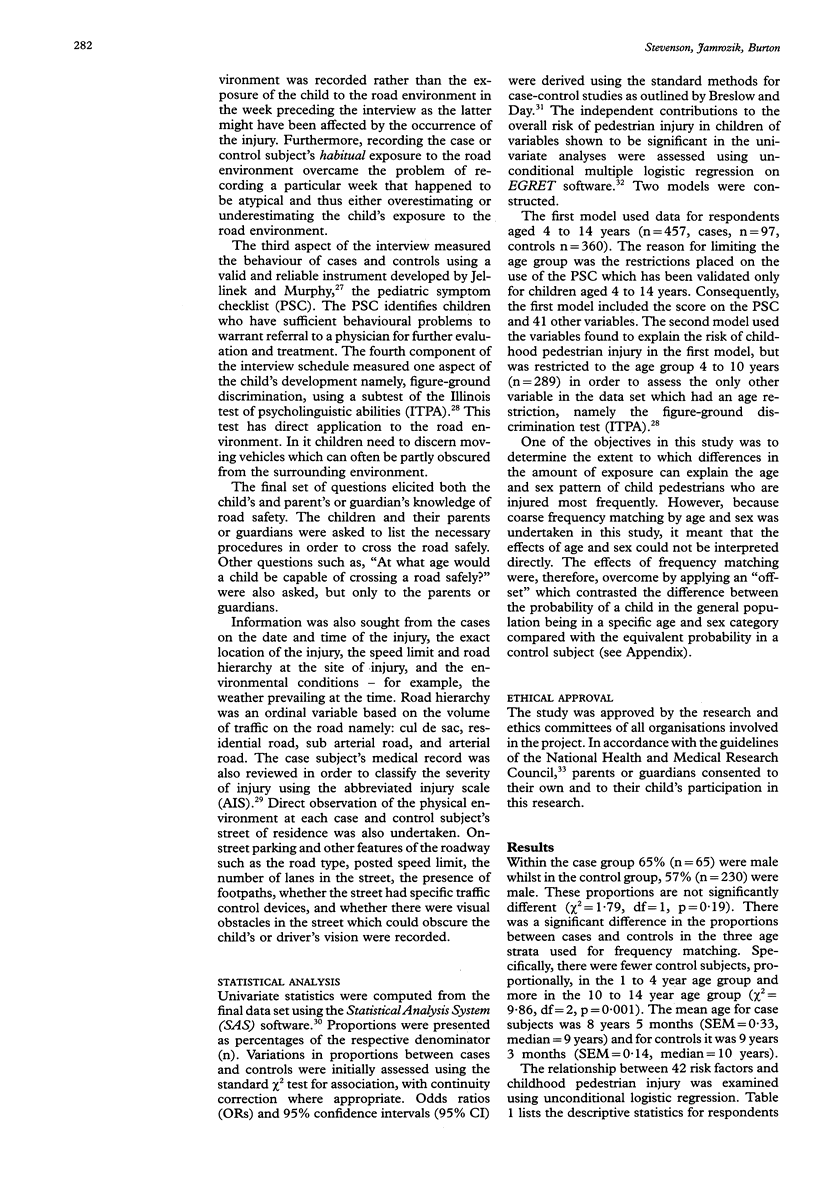
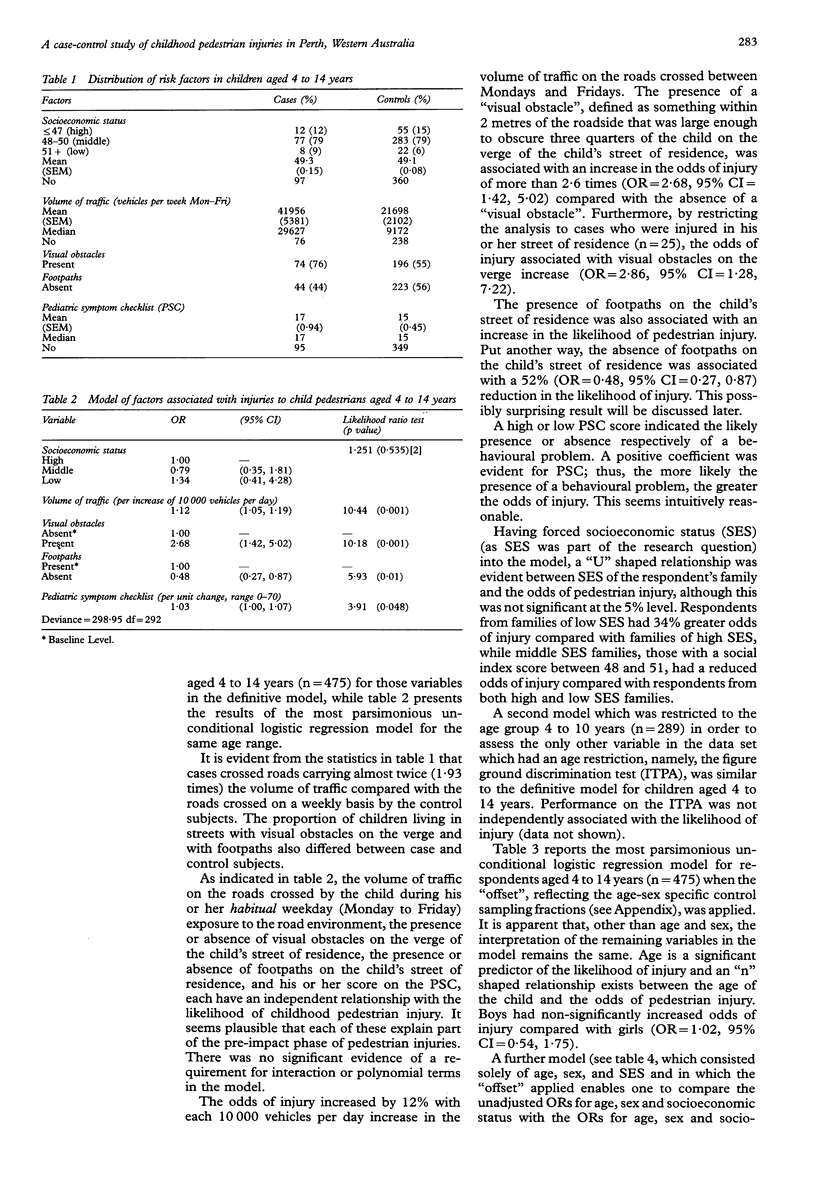
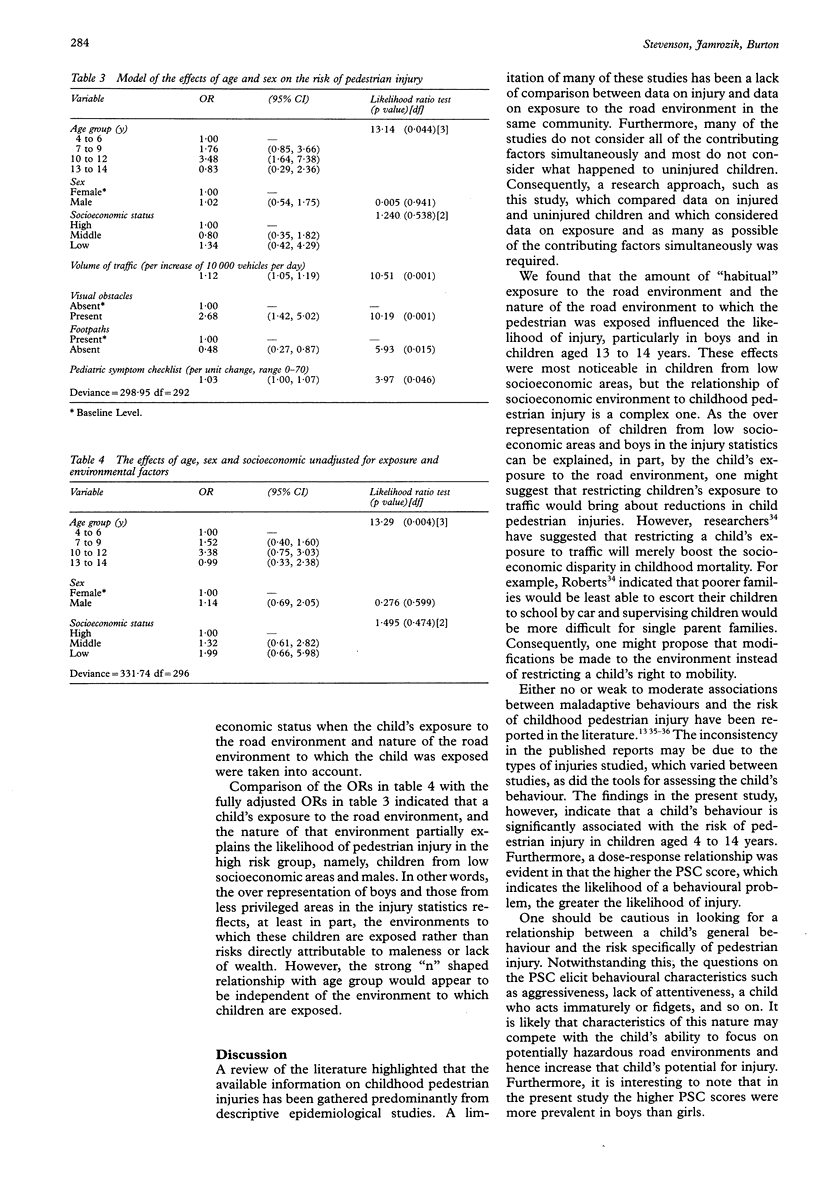
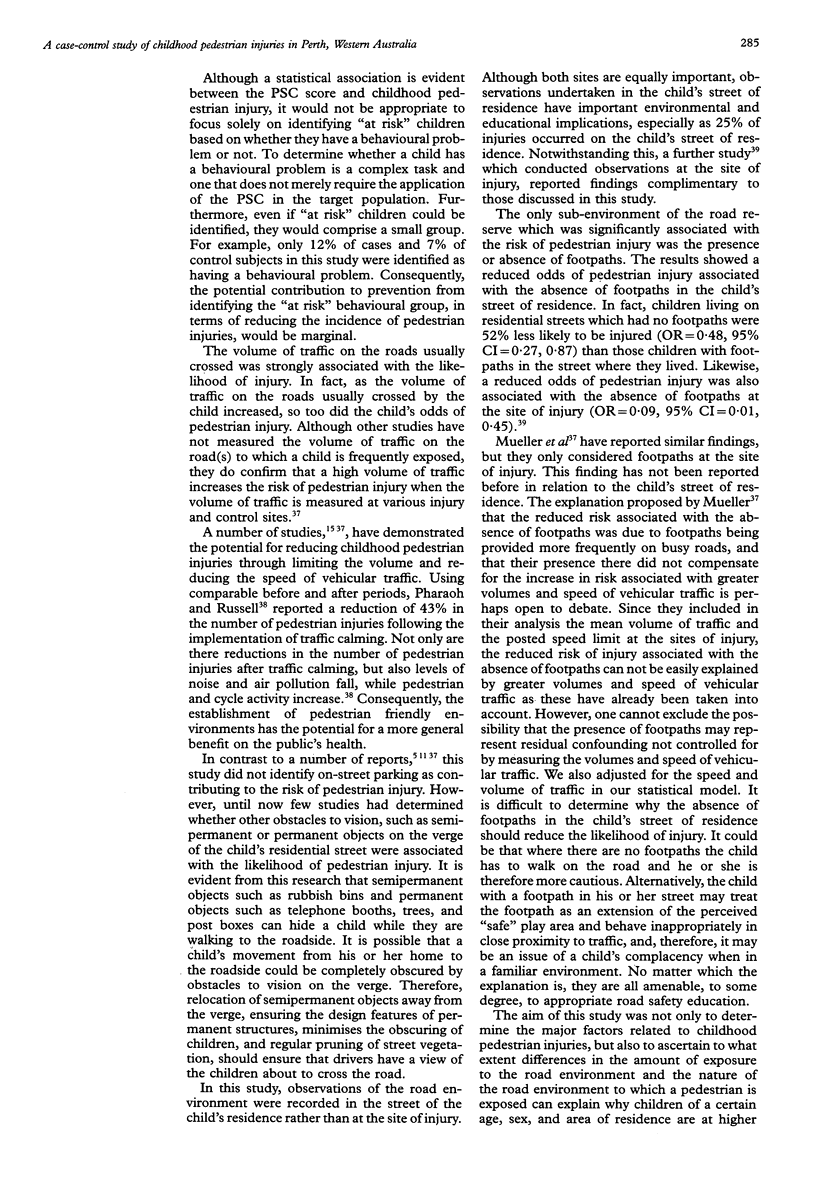
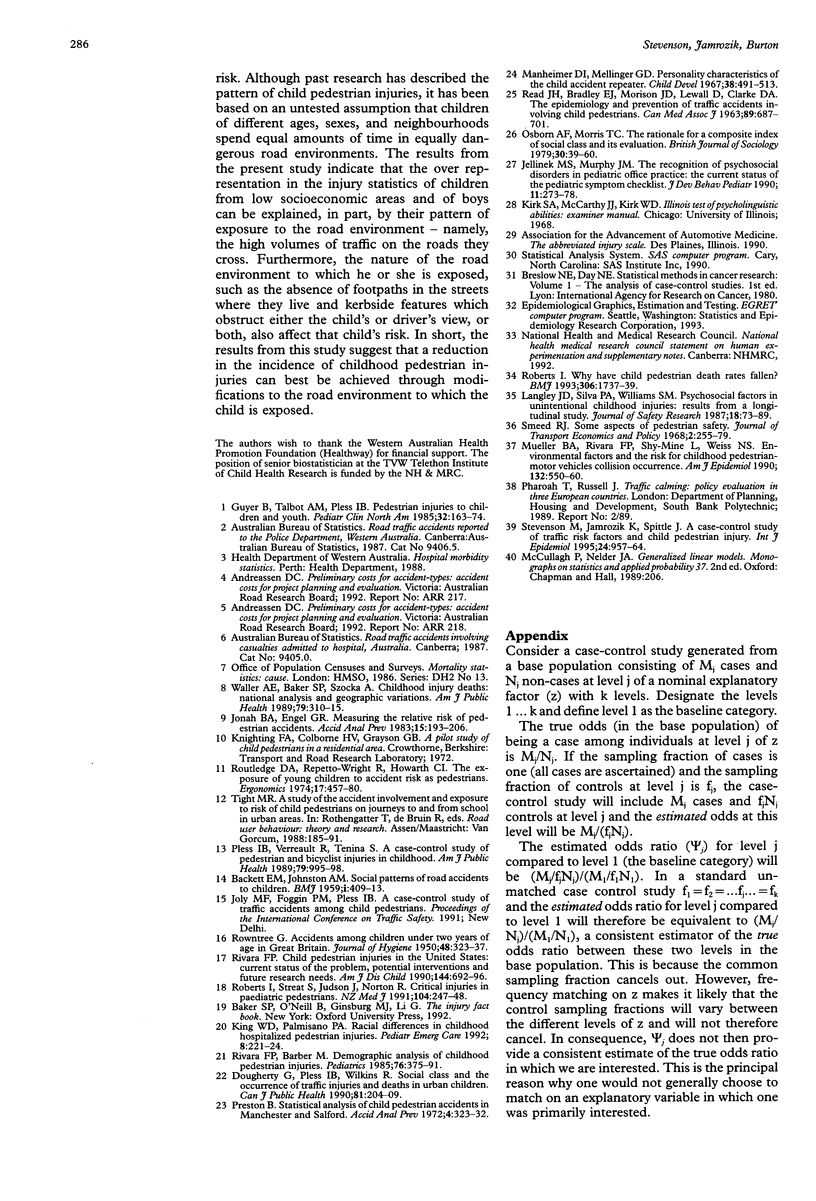
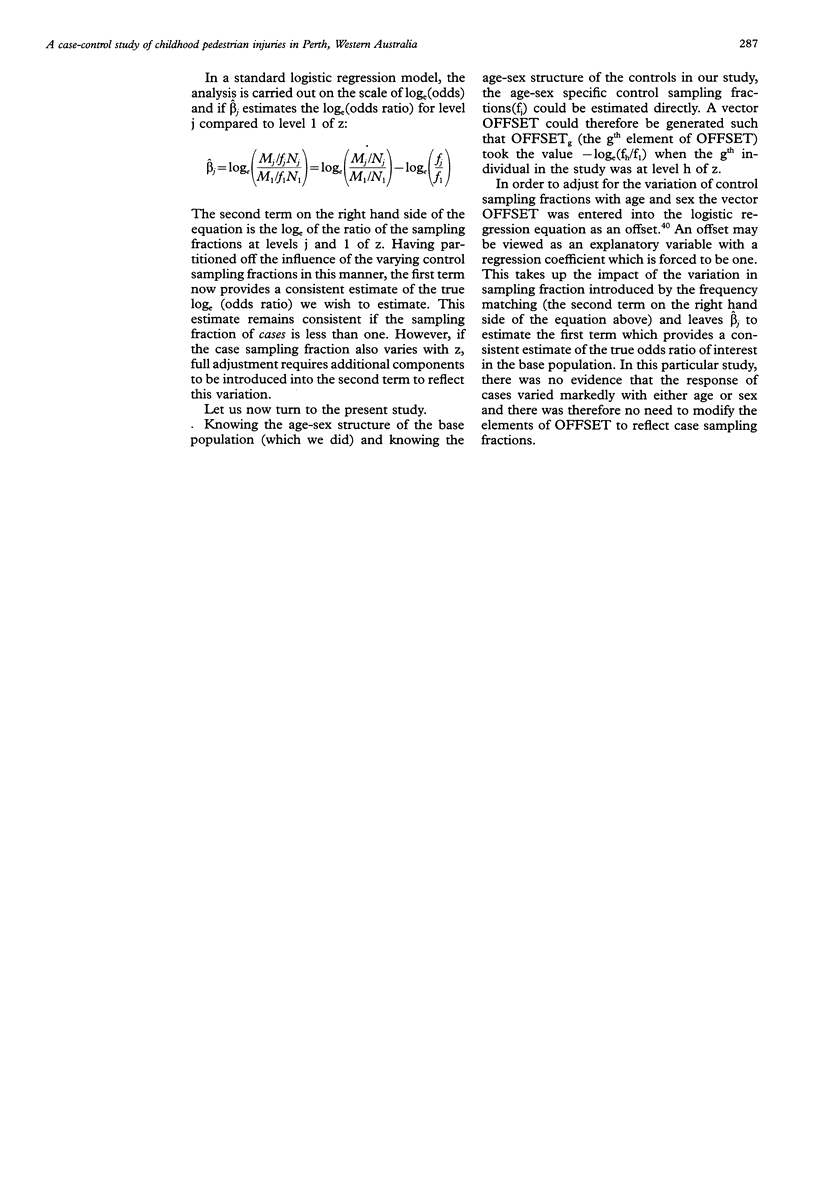
Selected References
These references are in PubMed. This may not be the complete list of references from this article.
- BACKETT E. M., JOHNSTON A. M. Social patterns of road accidents to children; some characteristics of vulnerable families. Br Med J. 1959 Feb 14;1(5119):409–413. doi: 10.1136/bmj.1.5119.409. [DOI] [PMC free article] [PubMed] [Google Scholar]
- Dougherty G., Pless I. B., Wilkins R. Social class and the occurrence of traffic injuries and deaths in urban children. Can J Public Health. 1990 May-Jun;81(3):204–209. [PubMed] [Google Scholar]
- Guyer B., Talbot A. M., Pless I. B. Pedestrian injuries to children and youth. Pediatr Clin North Am. 1985 Feb;32(1):163–174. doi: 10.1016/s0031-3955(16)34764-2. [DOI] [PubMed] [Google Scholar]
- Jellinek M. S., Murphy J. M. The recognition of psychosocial disorders in pediatric office practice: the current status of the pediatric symptom checklist. J Dev Behav Pediatr. 1990 Oct;11(5):273–278. [PubMed] [Google Scholar]
- King W. D., Palmisano P. A. Racial differences in childhood hospitalized pedestrian injuries. Pediatr Emerg Care. 1992 Aug;8(4):221–224. doi: 10.1097/00006565-199208000-00013. [DOI] [PubMed] [Google Scholar]
- Manheimer D. I., Mellinger G. D. Personality characteristics of the child accident repeater. Child Dev. 1967 Jun;38(2):491–513. [PubMed] [Google Scholar]
- Mueller B. A., Rivara F. P., Lii S. M., Weiss N. S. Environmental factors and the risk for childhood pedestrian-motor vehicle collision occurrence. Am J Epidemiol. 1990 Sep;132(3):550–560. doi: 10.1093/oxfordjournals.aje.a115691. [DOI] [PubMed] [Google Scholar]
- Pless I. B., Verreault R., Tenina S. A case-control study of pedestrian and bicyclist injuries in childhood. Am J Public Health. 1989 Aug;79(8):995–998. doi: 10.2105/ajph.79.8.995. [DOI] [PMC free article] [PubMed] [Google Scholar]
- READ J. H., BRADLEY E. J., MORISON J. D., LEWALL D., CLARKE D. A. THE EPIDEMIOLOGY AND PREVENTION OF TRAFFIC ACCIDENTS INVOLVING CHILD PEDESTRIANS. Can Med Assoc J. 1963 Oct 5;89:687–701. [PMC free article] [PubMed] [Google Scholar]
- Rivara F. P., Barber M. Demographic analysis of childhood pedestrian injuries. Pediatrics. 1985 Sep;76(3):375–381. [PubMed] [Google Scholar]
- Rivara F. P. Child pedestrian injuries in the United States. Current status of the problem, potential interventions, and future research needs. Am J Dis Child. 1990 Jun;144(6):692–696. doi: 10.1001/archpedi.1990.02150300090023. [DOI] [PubMed] [Google Scholar]
- Roberts I., Streat S., Judson J., Norton R. Critical injuries in paediatric pedestrians. N Z Med J. 1991 Jun 26;104(914):247–248. [PubMed] [Google Scholar]
- Roberts I. Why have child pedestrian death rates fallen? BMJ. 1993 Jun 26;306(6894):1737–1739. doi: 10.1136/bmj.306.6894.1737. [DOI] [PMC free article] [PubMed] [Google Scholar]
- Routledge D. A., Repetto-Wright R., Howarth C. I. The exposure of young children to accident risk as pedestrians. Ergonomics. 1974 Jul;17(4):457–480. doi: 10.1080/00140137408931377. [DOI] [PubMed] [Google Scholar]
- Stevenson M. R., Jamrozik K. D., Spittle J. A case-control study of traffic risk factors and child pedestrian injury. Int J Epidemiol. 1995 Oct;24(5):957–964. doi: 10.1093/ije/24.5.957. [DOI] [PubMed] [Google Scholar]
- Waller A. E., Baker S. P., Szocka A. Childhood injury deaths: national analysis and geographic variations. Am J Public Health. 1989 Mar;79(3):310–315. doi: 10.2105/ajph.79.3.310. [DOI] [PMC free article] [PubMed] [Google Scholar]


